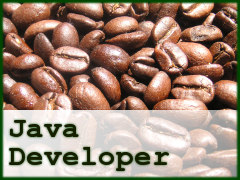A survey course in Java for programmers

- groups of 5-12 people,
- a survey of the whole universe of Java apps: web, desktop, mobile,
- save time: assumes some prior experience with programming,
- learn not only the language, but also Java coding conventions and technologies,
- hands-on workshop,
- 1290 EUR
- instalment payment plans available for private persons
more information here
Our course is intended for those who:
- want to learn the most commercially popular programming language and already know how to program in another language,
- know the basics of object-oriented programming and want to learn more about popular practices and design patterns,
- want to learn Java and discover the most popular technologies associated with it.
Requirements: we expect prospective students to have at least basic programming fluency (in any language).
During the classes students work on Windows, but we introduce some elements of Linux.
Valuable knowledge and skills
download detailed course programme >>
The main idea of the course is teaching programmers not only Java's syntax and basic libraries, but also its idioms, conventions and practices. We expect course participants to possess at least a basic programming experience; therefore, during the workshops they can focus on, for example, important differences between Java and other (particularly scripting) languages.
- HTML and CSS
- Joomla CMS
- JavaScript and jQuery (basics)
- JavaScript and HTML5 for programmers
- AngularJS and Single Page Applications
- PHP for programmers
- Symphony and Doctrine – web applications
- Zend Framework
- Zend Framework - supplemental training for the ZFCE exam
- Preparation to Zend Certified Engineer exam
The course encompasses Java as a language and several technologies important in the JVM world:
- web applications using servlets and JSP pages,
- applications with a graphical user interface (Swing), including applets,
- connecting to a database: both direct and using JPA (ORM),
- processing XML and JSON data.
64 hours are of course not enough to become an experienced Java programmer, but knowledge and skills acquired during the course should allow programmers to participate in Java-based projects and gather further skills by experience.
A graduate of our course will be able to:
- write in Java a web application with business logic based on JavaBean components that connect to a database, and presentation based on JSP;
- implement a web application on a servlet container or an application server (Tomcat and Glassfish will be used during the classes);
- write a desktop application that contains business UI components with database connections (tables, forms, lists), using platform-independent Swing library;
- write a program that uses web services returning XML or JSON;
- use and create simple JPA objects that comply with Enterprise Java Beans 3 specifications.
Course programme
Module 1
- A review of object-oriented programming: classes, interfaces, inheritance, the practical consequences of duck typing and static typing.
- A review of instructions and syntactic structures used in Java (with the exception of internal classes).
- Naming standards (SUN convention).
- The structure of the application, compilation, loading classes, Classloaders and CLASSPATH. Packages, code organization.
- Writing and preparing to distribute a simple console program in Java: the structure of the JAR.
- The “lets” philosophy: servlets, midlets, xlets, applets. Template methods.
- Writing a simple servlet, a first introduction to threads.
- The structure of Web applications in Java. WAR files.
Module 2
- Standard collections in Java: collections interfaces (all), implementations (commonly used) and algorithms.
- Components in Java: the concept of a JavaBean: features: read, write, announcement of notification.
- JSP – fast creation of web templates.
- Expression Language.
- Basic taglibs.
- JDBC: direct access to the database (for example JavaDB).
- Direct access to the database in JSP (standard taglib sql).
- Ant.
Module 3
- IDE: basics of IDE Netbeans.
- The factory and its role in statically typed languages.
- Internal classes: theory.
- Introduction to creating graphical user interfaces: Swing. Practical use of internal classes.
- Model MVC in Swing. Practical application of interfaces.
- More information about the threads. Threads in Swing.
- Implementation of data table model (JTableModel), a simple application with a GUI.
Module 4
- JavaBean components in Swing, create your own GUI component.
- Fundamentals of JSR 296 (Swing Application Framework) and JSR 295 (Beans Binding), with the support of Netbeans, use BeansBinding with its own component.
- A word about JavaFX – differences in binding between BeansBinding and JavaFX.
- Create and distribute applets; more advanced WebStart.
Module 5
- Input and output; operations.
- Java and XML Java and JSON. Practical methods for parsing the data in various formats (DOM and elementary JAXB).
- Java and annotation, JPA (part of the standard Enterprise Java Beans 3).
- JPA and threads, using JPA in a web application.